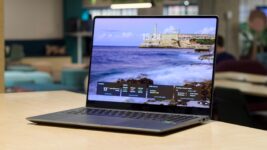
Samsung Galaxy Book4 Ultra review: Premium performance at a high price
The 2024 Ultra looks very similar – without having the two side-by-side I won’t actually use the word “identical” – to the previous model. The aluminium casing is solid and the Moonstone Grey matte finish is both smart and impervious to fingerprints. As an example of product design, however, it’s no more remarkable than the average kitchen appliance.
When it comes to practical matters the Ultra does rather better. At 1.63kg it’s reasonably light for a 16in laptop and it’s not too bulky either at 355 x 250 x 16.5mm. The Dell XPS 16 is heavier and thicker.
There’s a decent range of I/O ports here with a brace of Thunderbolt 4 ports and an HMDI 2.1 video output on the left. Plus, on the right, a 5Gbits/sec USB-A port, MicroSD card slot and 3.5mm audio jack. Of course, you have to surrender one of the USB-C ports to charging duties with the included 140W charger.
Incidentally, the MicroSD slot is a bit of a pain to use because the spring latch is set too deep, necessitating the use of a sharp tool to get it out. Unless you happen to have long fingernails, that is.
Wireless communications are handled by the ever-reliable Intel AX211 card, which supports Wi-Fi 6E and Bluetooth 5.3 rather than the very latest Wi-Fi 7 and Bluetooth 5.4 protocols.
Getting inside the Ultra involves prising off the four rubber feet, undoing the Torx screws they conceal and then getting brave with a spudger to loosen the plastic clips that hold the base plate very firmly in situ. All the major components and the RAM modules are soldered in place but there is a bay for a second M.2 2280 SSD, assuming you’ve bought a 1TB model.
READ NEXT: Best Wi-Fi extender
Samsung Galaxy Book4 Ultra: Keyboard, touchpad and webcam
I liked the feeling of solidity from the keyboard deck but the keys themselves don’t have a particularly satisfying action to them, feeling rather shallow and loose. Alongside this, the cursor keys are half-height efforts, which is a damned shame when there is masses of free space around them for a larger set of keys.
As one would expect from a 16in laptop there’s plenty of room for a number pad to the right of the keyboard and the keys that make it up are only fractionally narrower than those that make up the main keyboard. The keycap graphics are very clear, the three-stage white backlight works a treat and there’s a keyboard Fn lock.
There’s a fingerprint reader in the very top right corner, and slightly offset to the left on the deck below the keyboard you’ll find a whopper of a touchpad measuring a huge 150 x 106mm. The touchpad suffered none of the problems we found in the Galaxy Book3 Ultra. Here, it performed perfectly and the mechanical click action is quiet enough to prevent scowls in a library.
The 1080p (2MP) webcam won’t blow anyone’s socks off, however, with images appearing rather grainy in anything other than perfect light. The camera doesn’t have a privacy shutter, either, nor does it support Windows Hello facial recognition although you do get the full suite of Windows Studio Effects. All in all, it feels like rather thin gruel for a laptop this pricey.
READ NEXT: Best webcam
Samsung Galaxy Book4 Ultra: Display and audio
Buying a Samsung laptop with an OLED display is as close to a guarantee of a high-quality panel you can get, and the Ultra proved no exception to this rule. Its 16in 2,880 x 1,800 120Hz AMOLED 2X panel is a feast for the eyes and for the 2024 season Ultra comes with an added touch compatibility.
With Windows in SDR mode, peak brightness reaches a respectable 376cd/m2, but in HDR it jumps to 567cd/m2, more than enough to earn the Ultra its VESA DisplayHDR 500 True Black certification. There’s no lack of colour either – it’s capable of reproducing an impressive 115% of the DCI-P3 gamut – and the screen has four pre-calibrated colour profile settings to choose from: Vivid, sRGB, DCI-P3 and AdobeRGB.
Measured against the last three, the Delta E variance landed at 1.6, 1.2 and 1.6, respectively for each of these profiles, which is a fair rather than an exceptional level of accuracy for a machine aimed at serious creatives. More to the point, the results aren’t as good as the Galaxy Book3 Ultra which scored less than 1 against all profiles.
Colorimeter data aside, the Galaxy Book4’s screen does look superb in both SDR and HDR modes with limpid, saturated colours and the perfect contrast ratio — both enhanced by the high-gloss screen finish — that only OLED screens can deliver. The 120Hz refresh rate means motion handling is equally good, with very little ghosting or blurring and there’s a 60/120Hz dynamic switch to prevent undue battery drain.
Equally good is the laptop’s Dolby Atmos-enabled AKG quad speaker system. This comprises a pair of 5W woofers and 2W full-range drivers and delivers a deep, sonorous sound. It’s loud, too, generating 77.5dBA measured from a pink noise source at 1m.






